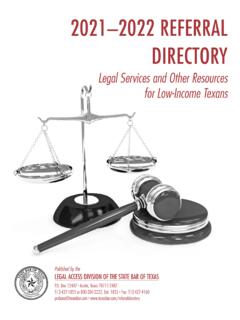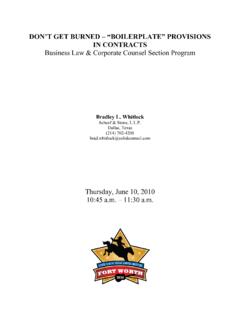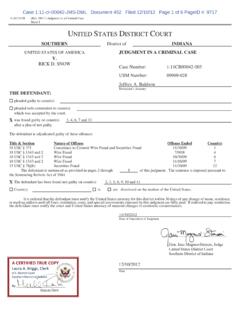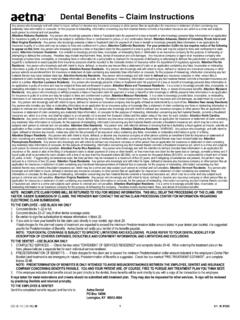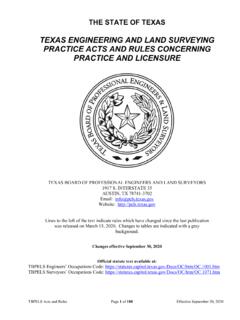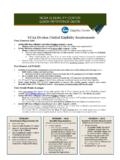Transcription of THE TEXAS CRIMINAL JUSTICE PROCESS
1 THE TEXAS CRIMINAL JUSTICEPROCESSACITIZEN S GUIDETHE STATE BAR OF TEXASCRIMINAL JUSTICE SECTION STATE BAR OF TEXASCRIMINAL JUSTICE SECTIONJ anuary 1, 1996 Revised 2005 The CRIMINAL JUSTICE Section of the State Bar of TEXAS is proud to present The TexasCriminal JUSTICE PROCESS A Citizen s Guide. This booklet is the culmination of threeyears of planning and preparation by various members of the CRIMINAL JUSTICE SectionCouncil who unselfishly devoted many hours of their time throughout the special thanks goes to Barry Macha, District Attorney in Wichita Falls, TEXAS .
2 Whoundertook the task of editing the booklet and putting it in its final form for membership of the CRIMINAL JUSTICE Section hopes this booklet will serve as a help-ful guide to a better understanding of the TEXAS CRIMINAL JUSTICE OF CONTENTSHOW ARE CRIMINAL OFFENSES CLASSIFIED? ..2 WHAT HAPPENS AFTER A CRIME IS COMMITTED? ..3 WHAT ARE THE RIGHTS OF CRIME VICTIMS?..4 WHAT IS THE CRIME VICTIMS COMPENSATION ACT? ..5 UNDER WHAT CIRCUMSTANCES IS AN ARREST MADE?..6 WHAT ARE THE RIGHTS OF THE PERSON ARRESTED?
3 6 HOW IS A CRIMINAL PROSECUTION INITIATED? ..7 WHAT ARE THE PROCEDURES BEFORE TRIAL?..8 HOW ARE CRIMINAL CASES RESOLVED?..8 WHAT ARE THE PLACES OF CONFINEMENT?..10 WHAT IS COMMUNITY SUPERVISION? ..10 WHAT IS AN APPEAL? ..11 WHAT IS PAROLE? ..11 ARE JUVENILES TREATED DIFFERENTLY? ..12 ARE COURT PROCEEDINGS OPEN TO THE PUBLIC? ..14 WHAT COURTS HANDLE CRIMINAL CASES? ..15 GLOSSARY ..16 Revised through the 2005 regular session of the 79th TEXAS ARE CRIMINAL OFFENSES CLASSIFIED?The TEXAS Legislature designates CRIMINAL offenses in our state s Penal Code as misdemeanorsor felonies.
4 Based on the relative seriousness of the offense, misdemeanors and felonies are clas-sified into the categories shown in the chart below and on the next attempt is one category lower than the offense attempted. CRIMINAL conspiracy is onecategory lower than the most serious felony that is the object of the conspiracy. CRIMINAL solic-itation is a first degree felony if the offense solicited is a capital felony; a second degree felonyif the offense solicited is a first degree felony. Provisions are made for enhanced (increased) punishments for repeat and habitual offenders,offenders who intentionally select the victim or property damaged or affected because of theoffender s bias or prejudice against a group, and offenders who administer or provide a con-trolled substance to the victim to facilitate commission of the and felony drug offenses are classified in the TEXAS Health and Safety Codebased on factors including: (1) the type and amount of drug.
5 And (2) whether the defendantmanufactured, delivered, or possessed the drug. Increased punishments are provided for cer-tain drug offenses occurring in drug-free zones and use of a child (younger than 18 years ofage) in commission of the person may not be prosecuted for or convicted of any offense committed when younger than15 except: (1) perjury and aggravated perjury; (2) a violation under Chapter 729,Transportation Code (except if conduct could result in confinement in jail or prison).
6 (3) aviolation of a motor vehicle traffic ordinance of an incorporated city or town; (4) a fine-onlymisdemeanor (other than public intoxication); (5) violations of penal ordinances of a politicalsubdivision; (6) a capital felony, an aggravated controlled substance felony, or first degreefelony and the person is 14 or older when the offense is committed and is transferred fromjuvenile court to district court for CRIMINAL proceedings; or (7) a capital felony or murder andthe person is 10 or older and under 17 when the offense is committed and is transferred fromjuvenile court to district court.
7 Unless the juvenile court transfers a child to district court forcriminal prosecution, the child may not be prosecuted for any offense committed before age17 except an offense described by (1)-(5) Class A Class BClass CPUNISHMENT upto 1 year in countyjail and/or a fine up to$4,000up to 180 days in countyjail and/or a fine up to$2,000fine only not to exceed$500 EXAMPLES Assault (causes bodily injury); Violating Protective/Magistrate s Order (first offense); Harassment (oneprior conviction) CRIMINAL Trespass (habitation orwith deadly weapon); Burglary of a Vehicle; DWI(one prior conviction).
8 Theft/ CRIMINAL Mischiefof$500 or moreTerroristic Threat; Indecent Exposure; Harassment(first offense); Disorderly Conduct (discharge/displayfirearm); DWI (first offense); Theft/ CRIMINAL Mischiefof $50 or moreAssault (threatens bodily injury or causes offensive orprovocative contact); Possession of AlcoholicBeverage in Motor Vehicle; Theft/ CRIMINAL Mischiefof less than $50 MISDEMEANORSWHAT HAPPENS AFTER A CRIME IS COMMITTED?After a crime is committed, the preliminary investigation by a law enforcement agency gener-ally begins when responding officers arrive at the scene of the incident.
9 Emergency matters arehandled and the crime scene secured. In most cases an officer will meet with the victim in per-son to obtain important information concerning the crime. Witnesses are questioned. Any sus-pect at the scene is detained, questioned, and then released or arrested, depending on the cir-cumstances. Additional responsibilities during the preliminary investigation may include: pho-tographing, videotaping, measuring and sketching the scene; searching for evidence; identify-ing, collecting, examining, and processing physical evidence; and recording all observationsand statements in a thorough preliminary investigation, many cases require a follow-up investigation toclose the case, arrest an offender, and/or recover weapons or stolen property.
10 The follow-upinvestigation can be conducted by the officers who responded to the original call or, most often,by detectives. Investigative leads that may need to be followed-up include: checking the victim sbackground; determining who would benefit from the crime and who had knowledge to plan3 CATEGORY Capital First DegreeSecond DegreeThird DegreeState JailPUNISHMENT death by lethal injection(only if 18 years of age orolder when offense com-mitted) or life imprison-ment without parole5to 99 years or lifeimprisonment, may alsobe fined up to $10,0002 to 20 years imprison-ment, may also be finedup to $10,0002 to 10 years imprison-ment, may also be finedup to $10,000180 days to 2 years instate jail, may also befined up to $10,000; orcourt may impose ClassAmisdemeanor punish-ment EXAMPLE(S)Capital Murder (murder peace officer or fireman.)


